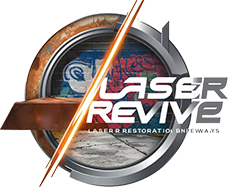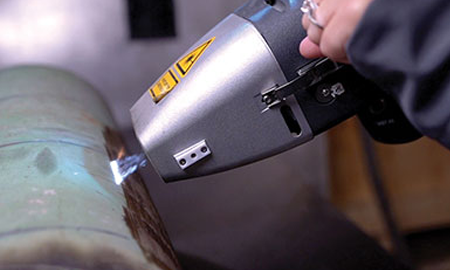When it comes to cleaning, the 21st century has handed us a new weapon: lasers. These high-tech beams of light aren’t just for sci-fi movies anymore; they’re revolutionizing how we clean everything from delicate artifacts to industrial machinery. But not all lasers are created equal. Different types of lasers offer unique benefits and are suited to specific applications. Let’s dive into the fascinating world of laser cleaning, with a touch of wit and a sprinkle of data to illuminate the topic.
1. Fiber Lasers: The Workhorse of Laser Cleaning
What Are They?
Fiber lasers are the trusty steeds of the laser world. They generate a laser beam by pumping light through optical fibers doped with rare-earth elements like ytterbium. Known for their efficiency and reliability, fiber lasers are widely used across various industries.
Applications:
Fiber lasers excel in metal cleaning, including rust removal, paint stripping, and surface preparation. Their high power and precision make them ideal for automotive, aerospace, and manufacturing industries.
Data Point:
According to a study by the Laser Institute of America, fiber lasers can achieve cleaning rates of up to 20 square meters per hour, depending on the power level and material being cleaned. This efficiency has made them a popular choice for industrial applications.
Witty Take:
Think of fiber lasers as the dependable Swiss Army knife in your cleaning toolkit—versatile, robust, and always ready to get the job done.
2. CO2 Lasers: The Gentle Giant
What Are They?
CO2 lasers are the gentle giants of the laser cleaning family. They produce a laser beam by electrically stimulating a mixture of carbon dioxide, nitrogen, and helium. These lasers are known for their ability to handle a wide range of materials with a softer touch.
Applications:
CO2 lasers are perfect for cleaning organic materials like wood, paper, and certain plastics. They are also used in delicate restoration work, such as cleaning historical artifacts and artworks.
Data Point:
Research from the National Institute of Standards and Technology (NIST) shows that CO2 lasers can remove contaminants with minimal damage to the underlying material, making them ideal for conservation work. They can clean surfaces at rates of up to 10 square meters per hour.
Witty Take:
Imagine CO2 lasers as the gentle, yet effective, feather duster of the laser world—carefully sweeping away grime without leaving a scratch.
3. Nd:YAG Lasers: The Precision Snipers
What Are They?
Neodymium-doped Yttrium Aluminum Garnet (Nd:YAG) lasers are the precision snipers in the laser arsenal. They generate a laser beam by doping a crystal with neodymium ions. These lasers are known for their high peak power and short pulse durations.
Applications:
Nd:YAG lasers are used for precision cleaning tasks where control is paramount, such as cleaning delicate electronics, medical devices, and fine jewelry.
Data Point:
A study published in the Journal of Laser Applications found that Nd:YAG lasers can clean surfaces with spot sizes as small as a few micrometers, offering unparalleled precision. This makes them perfect for tasks requiring meticulous detail.
Witty Take:
If fiber lasers are the Swiss Army knife, Nd:YAG lasers are the sniper rifle—taking aim with pinpoint accuracy to clean the trickiest spots.
4. Excimer Lasers: The Specialist Surgeons
What Are They?
Excimer lasers are the specialist surgeons of laser cleaning. They use a mixture of reactive gases like chlorine and fluorine to produce ultraviolet (UV) laser light. This UV light is absorbed efficiently by organic materials.
Applications:
Excimer lasers are employed in cleaning sensitive surfaces, such as semiconductor wafers, delicate polymers, and biomedical devices. Their precise control makes them ideal for applications requiring minimal thermal damage.
Data Point:
According to research by the IEEE, excimer lasers can remove contaminants at a microscopic level, achieving sub-micron precision. This capability is critical in the semiconductor and biomedical fields, where cleanliness standards are extremely high.
Witty Take:
Excimer lasers are like the brain surgeons of the laser world—performing highly specialized and delicate operations with extraordinary precision.
5. Ultrafast Lasers: The Speed Demons
What Are They?
Ultrafast lasers, also known as femtosecond lasers, are the speed demons of the laser cleaning family. They produce extremely short pulses of light, typically in the femtosecond (one quadrillionth of a second) range.
Applications:
These lasers are used in applications requiring ultrafast processing speeds and minimal thermal effects, such as microfabrication, precision cleaning of microelectronics, and surface texturing.
Data Point:
Research by the University of California shows that ultrafast lasers can ablate materials with virtually no heat-affected zone, making them ideal for delicate substrates. They can achieve cleaning rates of several square centimeters per second.
Witty Take:
Ultrafast lasers are the sports cars of the laser world—blazing through cleaning tasks at lightning speed, leaving no thermal skid marks behind.
6. Pulsed Lasers: The Jack-of-All-Trades
What Are They?
Pulsed lasers emit light in short bursts or pulses, rather than a continuous beam. This mode of operation allows for precise energy control, making pulsed lasers highly versatile.
Applications:
Pulsed lasers are used in a wide range of cleaning applications, from removing corrosion and paint to cleaning delicate surfaces in the electronics and aerospace industries.
Data Point:
A study by the European Physical Journal shows that pulsed lasers can be fine-tuned to deliver energy bursts with durations ranging from nanoseconds to femtoseconds, providing flexibility for various cleaning tasks. They can clean surfaces at rates of up to 15 square meters per hour.
Witty Take:
Pulsed lasers are the all-rounders—the jack-of-all-trades that can adapt to just about any cleaning challenge you throw at them.
Conclusion: Choosing the Right Laser for the Job
Laser cleaning technology offers a plethora of options, each with its unique strengths and ideal applications. Whether you need the versatility of a fiber laser, the gentle touch of a CO2 laser, the precision of an Nd:YAG laser, the specialization of an excimer laser, the speed of an ultrafast laser, or the adaptability of a pulsed laser, there’s a tool in the laser arsenal that’s up to the task.
As the data shows, each type of laser brings specific advantages to the table, making laser cleaning an increasingly popular choice across industries. The right laser can make all the difference, ensuring that surfaces are cleaned efficiently, safely, and with minimal impact on the underlying material.
So, the next time you think about cleaning, remember: lasers are more than just light shows and sci-fi props. They are powerful, precise, and ready to tackle even the toughest cleaning challenges with a beam of light.
Stay tuned to our blog for more insights into the fascinating world of laser technology and its myriad applications. Whether you’re a tech enthusiast, a professional in the field, or just curious about the future, we’ve got you covered.

